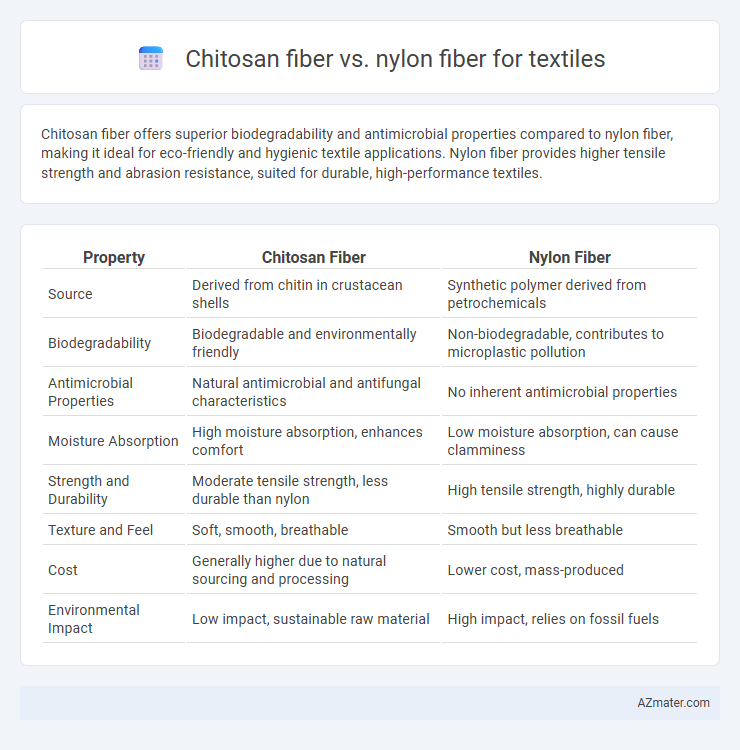Chitosan fiber offers superior biodegradability and antimicrobial properties compared to nylon fiber, making it ideal for eco-friendly and hygienic textile applications. Nylon fiber provides higher tensile strength and abrasion resistance, suited for durable, high-performance textiles.
Table of Comparison
| Property | Chitosan Fiber | Nylon Fiber |
|---|---|---|
| Source | Derived from chitin in crustacean shells | Synthetic polymer derived from petrochemicals |
| Biodegradability | Biodegradable and environmentally friendly | Non-biodegradable, contributes to microplastic pollution |
| Antimicrobial Properties | Natural antimicrobial and antifungal characteristics | No inherent antimicrobial properties |
| Moisture Absorption | High moisture absorption, enhances comfort | Low moisture absorption, can cause clamminess |
| Strength and Durability | Moderate tensile strength, less durable than nylon | High tensile strength, highly durable |
| Texture and Feel | Soft, smooth, breathable | Smooth but less breathable |
| Cost | Generally higher due to natural sourcing and processing | Lower cost, mass-produced |
| Environmental Impact | Low impact, sustainable raw material | High impact, relies on fossil fuels |
Introduction: Chitosan Fiber vs Nylon Fiber in Textiles
Chitosan fiber, derived from chitin found in crustacean shells, offers biodegradability and antimicrobial properties, making it a sustainable alternative to conventional nylon fiber in textiles. Nylon fiber, a synthetic polymer, is valued for its high strength, elasticity, and durability but poses environmental concerns due to its non-biodegradability and petrochemical origin. The growing demand for eco-friendly textile materials highlights the potential of chitosan fiber to replace nylon in applications requiring moisture management and antimicrobial functionality.
Origin and Production Methods
Chitosan fiber originates from chitin, a natural polysaccharide derived primarily from crustacean shells, making it biodegradable and sustainable. Its production involves dissolving chitin in acid solutions followed by spinning into fibers through wet or dry spinning methods. Nylon fiber, a synthetic polymer produced from petroleum-based chemicals, is manufactured via a melt spinning process after polymerization of caprolactam or hexamethylene diamine and adipic acid, resulting in strong, elastic fibers widely used in textiles.
Chemical Structure and Composition
Chitosan fiber is a biopolymer derived from chitin, primarily composed of N-acetyl-D-glucosamine units with abundant amino and hydroxyl groups, which provide biodegradability and antimicrobial properties in textiles. Nylon fiber, a synthetic polyamide, consists of repeating units of adipic acid and hexamethylene diamine linked by amide bonds, offering high tensile strength, elasticity, and resistance to chemicals. The chemical structure of chitosan contributes to moisture absorption and eco-friendliness, whereas nylon's synthetic composition ensures durability and versatility in fabric applications.
Mechanical Properties Comparison
Chitosan fiber exhibits superior biodegradability and antimicrobial properties compared to nylon fiber, making it highly suitable for eco-friendly textile applications. Mechanically, nylon fiber generally offers higher tensile strength and elasticity, providing excellent durability and flexibility essential for activewear and industrial uses. However, chitosan fibers demonstrate moderate tensile strength with better moisture absorption and thermal insulation, contributing to enhanced comfort in garments.
Biodegradability and Environmental Impact
Chitosan fiber, derived from natural sources like crustacean shells, offers superior biodegradability compared to synthetic nylon fiber, which can persist in the environment for decades. The biodegradation rate of chitosan fibers significantly reduces landfill waste and microplastic pollution, promoting a sustainable textile lifecycle. In contrast, nylon fibers contribute to environmental challenges due to their non-biodegradable nature and high energy consumption during production.
Moisture Absorption and Breathability
Chitosan fiber exhibits superior moisture absorption and breathability compared to nylon fiber, making it ideal for textile applications requiring high humidity control and comfort. Its natural polysaccharide structure enables efficient moisture-wicking and antimicrobial properties, enhancing wearer hygiene. In contrast, nylon fiber, a synthetic polymer, has lower moisture absorption and breathability, often resulting in reduced comfort in high-sweat conditions.
Antimicrobial and Functional Properties
Chitosan fiber exhibits superior antimicrobial properties compared to nylon fiber due to its natural biopolymer structure, which effectively inhibits bacterial growth and odors. The fiber's inherent biodegradability and moisture absorption enhance comfort and hygiene in textile applications, making it ideal for medical and activewear. Nylon fiber, while strong and durable, lacks intrinsic antimicrobial activity and typically requires chemical treatments to impart similar functionalities.
Applications in Textile Industry
Chitosan fiber offers superior biodegradability, antimicrobial properties, and moisture-wicking capabilities, making it ideal for sustainable activewear, medical textiles, and hygiene products. Nylon fiber is prized for its high tensile strength, elasticity, and abrasion resistance, commonly used in durable outerwear, sportswear, and industrial fabrics. The textile industry leverages chitosan fibers primarily for eco-friendly garments and functional textiles, while nylon fibers dominate in performance-driven applications requiring durability and resilience.
Cost-Effectiveness and Commercial Availability
Chitosan fiber offers eco-friendly properties and biodegradability, making it a cost-effective alternative in sustainable textile production, although its commercial availability remains limited compared to nylon. Nylon fiber is widely available and benefits from established mass production processes, resulting in lower costs and extensive supplier networks. The balance between chitosan fiber's environmental advantages and nylon's commercial scalability influences textile industry adoption decisions.
Future Trends and Innovations
Chitosan fiber, derived from natural sources like crustacean shells, offers biodegradability and antimicrobial properties that align with the growing demand for sustainable textiles, contrasting with traditional nylon fibers known for durability and elasticity. Innovations in chitosan fiber focus on enhancing mechanical strength and moisture management, positioning it as a viable eco-friendly alternative to petroleum-based nylon in fashion and technical textiles. Future trends indicate increased integration of chitosan with nanotechnology and smart textile developments to create advanced functional fabrics with reduced environmental impact.

Infographic: Chitosan fiber vs Nylon fiber for Textile
 azmater.com
azmater.com